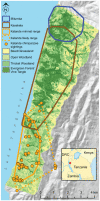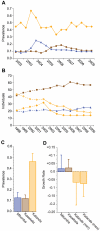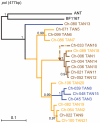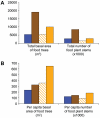Impact of simian immunodeficiency virus infection on chimpanzee population dynamics
- PMID: 20886099
- PMCID: PMC2944804
- DOI: 10.1371/journal.ppat.1001116
Impact of simian immunodeficiency virus infection on chimpanzee population dynamics
Abstract
Like human immunodeficiency virus type 1 (HIV-1), simian immunodeficiency virus of chimpanzees (SIVcpz) can cause CD4+ T cell loss and premature death. Here, we used molecular surveillance tools and mathematical modeling to estimate the impact of SIVcpz infection on chimpanzee population dynamics. Habituated (Mitumba and Kasekela) and non-habituated (Kalande) chimpanzees were studied in Gombe National Park, Tanzania. Ape population sizes were determined from demographic records (Mitumba and Kasekela) or individual sightings and genotyping (Kalande), while SIVcpz prevalence rates were monitored using non-invasive methods. Between 2002-2009, the Mitumba and Kasekela communities experienced mean annual growth rates of 1.9% and 2.4%, respectively, while Kalande chimpanzees suffered a significant decline, with a mean growth rate of -6.5% to -7.4%, depending on population estimates. A rapid decline in Kalande was first noted in the 1990s and originally attributed to poaching and reduced food sources. However, between 2002-2009, we found a mean SIVcpz prevalence in Kalande of 46.1%, which was almost four times higher than the prevalence in Mitumba (12.7%) and Kasekela (12.1%). To explore whether SIVcpz contributed to the Kalande decline, we used empirically determined SIVcpz transmission probabilities as well as chimpanzee mortality, mating and migration data to model the effect of viral pathogenicity on chimpanzee population growth. Deterministic calculations indicated that a prevalence of greater than 3.4% would result in negative growth and eventual population extinction, even using conservative mortality estimates. However, stochastic models revealed that in representative populations, SIVcpz, and not its host species, frequently went extinct. High SIVcpz transmission probability and excess mortality reduced population persistence, while intercommunity migration often rescued infected communities, even when immigrating females had a chance of being SIVcpz infected. Together, these results suggest that the decline of the Kalande community was caused, at least in part, by high levels of SIVcpz infection. However, population extinction is not an inevitable consequence of SIVcpz infection, but depends on additional variables, such as migration, that promote survival. These findings are consistent with the uneven distribution of SIVcpz throughout central Africa and explain how chimpanzees in Gombe and elsewhere can be at equipoise with this pathogen.
Conflict of interest statement
The authors have declared that no competing interests exist.
Figures







References
-
- Silvestri G. Immunity in natural SIV infections. J Intern Med. 2008;265:97–109. - PubMed
-
- Walsh PD, Abernethy KA, Bermejo M, Beyers R, De Wachter P, et al. Catastrophic ape decline in western equatorial Africa. Nature. 2003;422:611–614. - PubMed
-
- Campbell G, Kuehl H, N'Goran Kouamé P, Boesch C. Alarming decline of West African chimpanzees in Côte d'Ivoire. Curr Biol. 2008;18:R903–R904. - PubMed
-
- Köndgen S, Kühl H, N'Goran PK, Walsh PD, Schenk SS, et al. Pandemic human viruses cause decline of endangered great apes. Curr Biol. 2008;18:1–5. - PubMed
Publication types
MeSH terms
Substances
Grants and funding
LinkOut - more resources
Full Text Sources
Molecular Biology Databases
Research Materials
Miscellaneous

